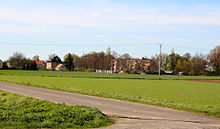Głogowiec (Oberglogau)
| Głogowiec | ||
|---|---|---|

|
|
|
| Basic data | ||
| State : | Poland | |
| Voivodeship : | Opole | |
| Powiat : | Prudnik | |
| District of: | Upper Logau | |
| Geographic location : | 50 ° 20 ' N , 17 ° 51' E | |
| Residents : | ||
| Telephone code : | (+48) 77 | |
| License plate : | OPR | |
| Economy and Transport | ||
| Next international airport : | Katowice | |
Głogowiec (German: Glöbaren ) is a district of Oberglogau ( Głogówek ) in Poland in Upper Silesia . It has a Schulzenamt .
geography
Geographical location
Głogowiec is located in the south of the city of Oberglogau. The Osobłoga ( | Hotzenplotz ), a tributary of the Oder, and the Mühlgraben flow west of Głogowiec . The railway line from Prudnik (Neustadt OS) to Koźle (Cosel) runs north of Głogowiec .
Neighboring places
Neighboring towns of Głogowiec in the West Dzierżysławice (Dzierżysławice) , north of the Oberglogauer district Oracze (Hintersdorf) and the city center, in the northeast of Stare Kotkowice (Stare Kotkowice) and in the south Tomice (Thomnitz).
history
The place was first mentioned in 1295 in the Liber fundationis episcopatus Vratislaviensis as "Glogovetz". In a document dated February 2, 1298, the place is mentioned in a document as Glogoviz . In a document dated December 24, 1311, the place is mentioned as Glogovicz and a person named Lorenz is named as the lord and heir of the possible. In 1784 the place, which belonged to the Oberglogau lordship, had 12 gardeners, three cottagers and a farm . In addition to the spelling Gloglich, the names Glogowiz and Glöchlichen are also mentioned. In 1818 the place, which was then written Gloglich , had 12 gardeners, nine cottagers and a farm . In 1865 the place had 13 gardeners and seven cottages and three manorial estates. There was also a watermill and a beer and brandy bar. Glöbaren was parish and schooled to Oberglogau. In addition to the village community, there was also a pertinence estate with the Thiergarten Vorwerk.
In the referendum in Upper Silesia on March 20, 1921, 138 eligible voters voted to remain in Germany and 19 to belong to Poland. Possible remained with the German Empire . 1933 lived in the place 242 inhabitants. In 1939 the place had 239 inhabitants. Until 1945 the place was in the district of Neustadt OS
In 1945 the previously German place came under Polish administration and was renamed Głogowiec and joined the Silesian Voivodeship. In 1950 the place came to the Opole Voivodeship and since 1999 it has belonged to the powiat Prudnicki . On April 22, 2009, German was introduced as the second official language in the municipality of Oberglogau.
Attractions
- Path chapel with bell tower. A memorial plaque for those who died in the First World War is attached to the facade.
- crossroads
- The Wide Chapel , a baroque path chapel from 1762.
societies
Web links
Individual evidence
- ↑ Codex Diplomaticus Silesiae: Part 7 - Regesta on Silesian history. Third part. Until 1300
- ↑ Codex Diplomaticus Silesiae: 16 - Regesta on Silesian history 1301-1315 ( page no longer available , search in web archives ) Info: The link was automatically marked as defective. Please check the link according to the instructions and then remove this notice.
- ^ Johann Ernst Tramp: Additions to the Description of Silesia, Volume 3 , Brieg 1784
- ^ Geographical-statistical handbook on Silesia and the County of Glatz, Volume 2 ; Breslau and Jauer 1818
- ↑ Cf. Felix Triest: Topographisches Handbuch von Oberschlesien , Breslau 1865
- ↑ See results of the referendum in Upper Silesia of 1921 ( Memento of January 29, 2017 in the Internet Archive )
- ^ Michael Rademacher: German administrative history from the unification of the empire in 1871 to the reunification in 1990. Neustadt district in Upper Silesia (Polish Prudnik). (Online material for the dissertation, Osnabrück 2006).




